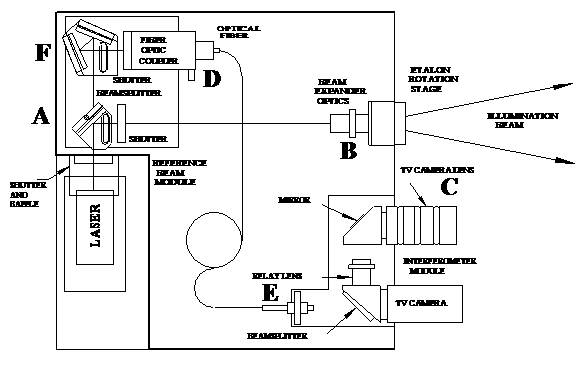
This diagram illustrates the modular design of the Electronic Holography optical head mounted on an 18-inch square pallet. It is composed of 3 modules: an interferometer module, a beamsplitter module, and an illumination module, which can be attached to the beamsplitter module to form a single unit. The interferometer and beamsplitter modules are connected by a polarization preserving optical fiber that provides the reference beam for the interferometer. This is greatly superior to a reference beam propagating in free space because it provides stable alignment.
The
design of the interferometer module eliminates problems found in
most competing designs. First,
the beamsplitter is approximately 90% reflective and oriented so that
the image forming rays never pass through it.
That orientation eliminates image aberrations and also eliminates
patterns in the reference beam from reflections by the second surface.
The primary image-forming lens is a standard TV zoom lens on a
standard C-mount. This is
followed by a field lens and a high-quality relay lens to bring the
image to the TV camera with no vignetting or aberrations.
The imaging lens is mounted on a translation stage to facilitate
focusing.
The
beamsplitter module also uses a high reflection beamsplitter to direct
the majority of the laser light to the object. The remainder is
reflected by two piezo-electrically actuated mirrors to the fiber optic
coupler. Two compact rotary
shutters are incorporated to switch the illumination and reference beams
on and off independently. During
the calibration, the interferometry program measures the ratio of the
object beam to reference beam at the TV camera.
The beam ratio can be adjusted over a wide range by defocusing
the reference beam on the end of the optical fiber.
The
illumination module consists of a pair of lenses, one stationary and one
movable along its axis, which can expand or compress the illumination
beam over a wide range. An anamorphic prism beam expander is also
available to elongate the profile of the beam to provide uniform
illumination of oblong-shaped objects. The illumination beam also
passes through a tilted etalon that shifts the beam laterally without
changing its direction of propagation. When this assembly rotates,
the speckles on the object seen by the TV camera change, and this is
used to eliminate speckles by averaging.
The layout of the K100/HOL optical head is simple and provides easy access to all adjustments. The protective cover is a set of sides that bolts to the pallet capped with a hinged lid so that the user has instant and easy access to any necessary adjustment. An interlock switch is installed to shut off the laser if an unauthorized person opens the lid.